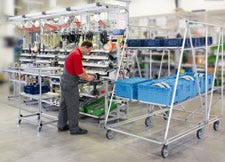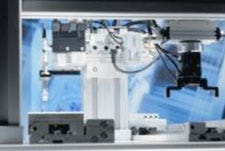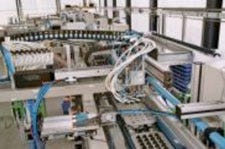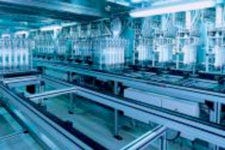Lean Manufacturing and Sustainability for Medical Device Manufacturers
Lean manufacturing and green manufacturing are not always considered at the same time as companies plan their factory improvement initiatives. Often, in “going green,” a company will aim for a certain certification, such as ISO 14001, and will plan specific initiatives to achieve that goal. Sometimes the specific actions will be tied to lean manufacturing initiatives, but most often they are not.
August 11, 2011
Lean manufacturing and green manufacturing are not always considered at the same time as companies plan their factory improvement initiatives. Often, in “going green,” a company will aim for a certain certification, such as ISO 14001, and will plan specific initiatives to achieve that goal. Sometimes, the actions the firm takes will be tied to lean manufacturing initiatives, but most often they are not.
|
|---|
Strategies involving the use of various material carts, line-side flow racks, gravity-fed conveyors or other inventory replenishment tools can help reduce the waste involved in getting material from the stockroom to the assembly work cell. |
Similarly, the emphasis with lean is mostly on reducing the classical “seven types of waste” (known as muda in Japanese), which include: defects and errors; waiting; inefficient processes; overproduction; excess inventory; wasted motion and movement; and finally, excessive material handling. However, since both green and lean actions often influence each other in a positive way, it’s a mistake to decouple these initiatives.
In fact, diligent attention to lean factory initiatives can lead to a “greener” factory, and this can be made visible to plant management by observing and measuring waste reduction from a green point of view as well. In general, medical device manufacturing environments have a head start in both lean and green, since they’re generally well-organized and clean; however, opportunities for improvement usually reveal themselves quickly when one starts looking for them. Reducing waste is certainly a worthwhile enterprise as it is both lean and green.
Material Flow: Look Beyond Inventory
Inventory reduction is one of the classical measurements for determining the effectiveness of a company’s lean activities, because it’s the end result of smart material flow strategies deployed throughout the plant. It’s also a financial performance metric that companies already measure, possibly in dollars, numbers of inventory “turns,” or reductions in scrap. Don’t stop measuring these things; they’re important indicators of your business’s health. But if you reduce the amount of inventory that you’re moving into and out of the warehouse, or if you’ve repositioned the inventory so that travel pathways to value-added assembly work cells are shorter, aren’t you also reducing the amount of energy your forklifts use in moving it around? Jamie Flinchbaugh, author of “The Hitchhiker’s Guide to Lean” and a founding partner at the Lean Learning Center (Novi, MI), explored this very subject in a podcast on “Lean and Sustainability” in Rexroth’s Lean Podcast Library, citing the savings in forklift-related propane costs and emissions, electricity to charge the batteries, even potential reductions in land use and other resources. Indeed, if you’re able to eliminate the use of one or more forklifts altogether, make sure that you don’t just measure the immediate savings from the sale of the forklift or discontinuing its lease. Make sure to consider the “green” savings as well, by calculating the long-term cost savings from lowered energy use. Bottom line? By implementing lean in a broad manner, the company is, in fact, also becoming greener.
|
|---|
Even the materials used in building workstations present opportunities to reduce waste. For example, using bolt-together aluminum framing systems rather than welded steel offers the advantages of faster and more modular assembly capabilities with reusable materials that won’t end up as scrap metal. |
But a thorough analysis of lean material flow strategies offers even more opportunity to reduce your company’s environmental impact. Whether your company makes hearing aids, blood pressure cuffs, metal implants, wheelchairs or hospital beds, you can find ways to improve the flow of materials throughout your value stream. Often a review of waste in material flow will show that travel distances from the stockroom to the assembly work cell or machining center are too long. A host of strategies exists to overcome this, and these often include the use of various material carts, line-side flow racks, gravity-feed conveyors, or other inventory-replenishment tools. Any style of these carts is fine, right? Not necessarily. What companies sometimes fail to consider is the material used to build these new items, and this is another area where lean strategies and green thinking intersect and help each other.
How? Consider the pace of innovation among medical devices. Where innovation is rapid, frequent, and sometimes game-changing, lean systems will have to change frequently to meet customers’ changing demands. The technologies you choose to implement your lean strategies will need to keep up. Some technologies can not only add environmental benefits, but also meet the need for flexibility. For the types of structures used in inventory replenishment techniques, for example, bolt-together aluminum framing systems offer several advantages over welded steel or stainless steel. Steel structures can be difficult to repurpose, they tend to rust (unless stainless), and you need to paint them periodically. Building the same types of structures from aluminum framing gives you much more flexibility. It also allows you to disassemble a workstation, if no longer needed, and reconfigure the parts into a cart or flow rack. There’s also no energy used in welding or painting, and you don’t have structures that are no longer useful taking up valuable floor space or going to a landfill. As an extra benefit to medical and other “clean” manufacturers, it’s also possible to find cleanroom-certified versions of many of these products for use in medical labs and clean medical device assembly areas.
By looking at material flow strategies from both perspectives, lean and green, we’re able to find additional ways to get leaner and greener, cutting not only manufacturing waste, but reducing our environmental footprint, as well.
What About Automation?
One of the key questions facing lean practitioners is whether automation even fits into a lean strategy. Our experience is that the reduction of waste takes priority over dogma, and the best way to approach any process or task generally reveals itself under the bright light of thorough evaluation.
In general, medical device manufacturing environments have a head start in both lean and green |
In medical device manufacturing, it’s common to find a need for extreme precision in assembly processes. Although human labor is the most flexible kind, it might not be possible to guide a tool, for example, to the exact location each time as parts are presented. And where electronics are present, you might also need to provide an ESD-safe environment to avoid damaging sensitive electronics. In these circumstances, using automation frequently makes sense because it allows for much greater control over precision assembly or manufacturing processes. Greater control means higher quality results, and less waste.
The intersection between green and lean is particularly important if automation is part of your lean manufacturing system, since the energy used in automation is a potentially significant source of waste. In fact, it’s probably a good idea to add an eighth type of waste to your lean considerations: excessive energy use. Fortunately, some suppliers of automation technologies can help design systems that are optimized for the most efficient use of energy. Many of these same suppliers can offer a kind of energy “audit” of existing systems, too, and make recommendations that can be applied retroactively to save energy.
Pneumatics: Air Is Everywhere
Compressed air is used widely in manufacturing facilities worldwide to power a variety of activities. From pneumatic screwdrivers in manual assembly processes, to pneumatic actuators and grippers in pick-and-place operations, to pneumatic routing and handling devices in conveyor systems, the routing and deployment of compressed air is ubiquitous. Indeed, many companies offer specialized technologies for medical device manufacturing—for example, to provide gentle handling of sensitive components or to accommodate the compact design or cleanliness requirements of automated systems in the medical industry. Because pneumatics are so widely used and because energy costs can make up more than half the total cost of ownership in pneumatics today, a detailed review of planned or existing pneumatics applications can pay off very quickly medical device companies.
The key is to avoid dead volumes and to optimize pressures. More air is not necessarily better. What’s most important is to provide the amount that’s needed to the right place at the right time. To achieve this, lean practitioners should look at three factors: dimensioning, hose lengths, and pressure regulation.
Dimensioning
|
|---|
Proper sizing of pneumatic components is a prerequisite for optimal energy usage. Using equipment that’s sized according to the given application can save at least 15 percent of air volume rather than using a one-size-fits-all approach in component selection. |
Sizing a system’s pneumatics components appropriately is a prerequisite for optimal energy usage. The “more is better” strategy is a recipe for waste, since over-dimensioning causes unnecessarily high air consumption. Even great efforts at saving energy will not lead to the best solution if the components of your pneumatic system are not designed to match your requirements in the first place. Over-dimensioning is a common practice, but building in more capacity “just in case” simply designs wasted energy into the system. At least 15% of air volume can be saved through compact and economical approaches that use cylinders and valves designed to be much smaller. Applied over the life of your system, these savings can add up to significant amounts.
Hose Length and Decentralization
It may seem obvious, but the longer the hose connections in a centralized compressed air delivery system, the more volume must be filled. Centralized systems are not only cumbersome to manage because of the long air supply lines, but they also consume a lot of energy. Small, decentralized units at the site of the application can reduce the length and number of hoses and connections, resulting in significant savings. In fact, designing a decentralized system based on cylinder and valves can eliminate many of the air lines in a conventional system and reduce energy use by more than 30%. This concentration of pneumatic functions prevents pressure losses through long supply lines from the control cabinet to the pneumatic drive.
Pressure regulation
Use only as much pressure as necessary. Again, it seems straightforward, but in leaky systems where the needed pressure might not be predictable, it can be tempting to overcompensate. The newest pressure regulators can help overcome this by combining digital control electronics with innovative proportional technology to allow for sophisticated pressure control. The intelligent control constantly compares the specified value with the actual value to ensure exact metering, which also allows cylinder strokes to be driven in “idle” mode with a reduced pressure. As soon as the application requires full performance, the required pressure is provided by a dynamic electropneumatic control. The right pressure for each task can lower energy consumption by 25%.
Assembly and Automation: Small Details Can Add Up
So far in this article, we’ve looked at lean and green manufacturing from the perspective of relatively large strategies and systems—an important approach if we’re looking for large opportunities to cut waste and save energy. But savings can often be achieved in designing new automation for individual processes. Multiaxis Cartesian robotics systems, for example, are commonly used in medical device assembly and laboratory automation, and can also be optimized to be lean and green.
|
|---|
Cartesian robotic systems, commonly used in medical device assembly, can be optimized to be lean and green. For example, sizing linear motion components according to the loads being carried can reduce the energy requirements needed to power the system. |
The author refers to the following acronym to guide customers to optimize system design: "LOSTPED." The letters stand for Load, Orientation, Speed, Travel, Precision, Environment and Duty cycle, and the trick is to balance the inherent trade-offs to achieve the most efficient system, with the lowest total cost of ownership.
How does this work? Let’s take a look at just two factors, load and precision, because this is a tradeoff that will be common in the medical device industry. In many cases, device assembly will not require heavy loads to be picked up, moved, and positioned. As a result, it may be possible to use actuators that weigh less themselves, so that in a three-axis system, you’re moving less combined weight over the entire move profile. This alone will save energy. But if you also need extremely high precision, an overemphasis on “lightweighting” the components in the system might not give you the rigidity that you need to control the action of the tool at the end of the actuator. Going overboard in either direction will result in waste: The overly heavy-duty system will have a higher initial purchase price, as well as excessive ongoing energy costs; the underdesigned system will cost less initially, but might cause quality problems and waste. The right system will give you the best combination of both: the most efficient use of energy and a system that will achieve your quality needs. That’s what LOSTPED is all about.
|
|---|
A thorough analysis of lean material flow strategies throughout the manufacturing process, whether for manual or automated assembly, offers many opportunities to reduce a company’s environmental impact. |
Of course, there’s much more to electromechanical system design than sizing the mechanical components. From an energy-saving standpoint, the electrical side is potentially even more important: An oversized motor, for instance, will naturally use more energy than the right-sized one. But what’s most important is matching the servomotor, servodrive, and drive controller to achieve the best possible energy efficiency. Some of these systems can achieve significant savings by supplying “energy on demand,” in other words, supplying power only during the active part of the system’s move profile. Naturally, the needs for any given application will vary widely, so it’s best to consult with your automation supplier or mechatronics application experts to make sure that you get the most efficient system. But building in energy savings that can be realized day in and day out not only helps you become leaner and greener, it also helps put money back on your bottom line.
What’s Lean Is Green, and Vice Versa
While many manufacturing companies are actively working on lean initiatives in the United States, strategies for sustainable manufacturing have sometimes taken a back seat because energy costs have generally been lower compared to those in Western Europe. However, by looking at manufacturing strategies through a green lens, medical device makers everywhere can find opportunities to cut waste even further in their lean activities. Waste is simply that, whether it’s waiting time, excessive parts movement or handling, or wasted energy. By taking advantage of some of the larger opportunities for cutting waste in manufacturing and assembly operations, medical device makers can become both greener and leaner. The result can only be a stronger bottom line. And that’s always a good place to see green.
Kevin Gingerich is manager, marketing and e-communications at Bosch Rexroth Corp. (Buchanan, MI).
About the Author(s)
You May Also Like






.png?width=300&auto=webp&quality=80&disable=upscale)
